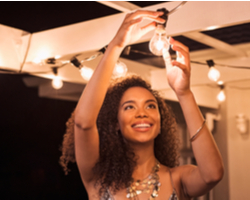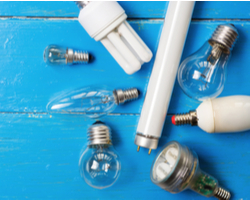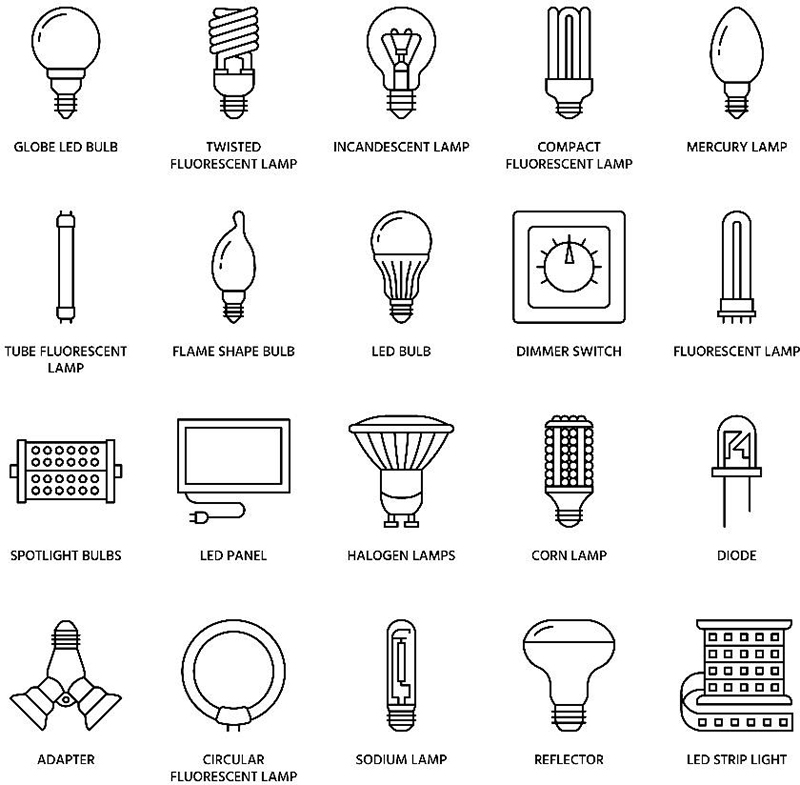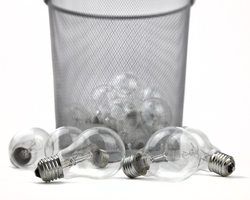How many people does it take to change a light bulb? With any luck, only you. While changing a light globe won’t go down in DIY folklore, it can be complicated if you have no idea what you’re doing. In this guide, we’ll cover everything you need to know about replacing light globes so you’re not left in the dark.
How to change a light bulb

The easiest way to change a light globe safely is to understand the main features of the product, as well as its installation requirements. Before you change a fixture’s bulb, you will need to know the type of replacement it needs. In Australia, most household light sockets will generally hold a bulb that clips or screws into place. The two most common types are called a ‘bayonet cap’ and ‘screw cap’, however there are many variations and other kinds on the market.
As a general rule of thumb, you can follow these steps:
- Step 1: Turn off power at the switchboard, lamp or wall socket
- Step 2: Use a ladder or safety step if needed and wear protective gloves
- Step 3: Remove any screws or clips holding glass or plastic domes over the bulb
- Step 4: Remove existing bulb by gently rotating anticlockwise if it’s a screw cap, or push upwards and twist anticlockwise until it clicks out of socket if it’s a bayonet cap
- Step 5: Place new bulb into socket according to lighting fixture
- Step 6: Turn power back on and switch light on to test
- Step 7: Safely dispose of old light bulb
It’s important to note that the above information is only intended for the replacement of standard residential light bulbs that don’t require fitting from a licenced electrician. There are various types of light globes in Australia, which we’ll go into further detail below.
How to change a light bulb in the ceiling
Replacing overhead light bulbs in ceilings can be challenging, but it doesn’t have to be. By following the steps outlined above, the only difference will be the size of ladder or safety step that’s needed to safely gain access to the light. Remember to never use a chair or piece of furniture where you can lose balance, and ensure the ladder or safety step is on level ground before climbing.
Are all light bulb types easy to change?

Not all light bulbs are a piece of cake to replace, and in some cases, will involve more work, or the help from a licenced professional. Again, this will come back to the type of light bulb needed and its positioning in the house. Some fixtures, like downlights or outdoor lights, may require covers to be first be removed before accessing the bulb.
Melbourne-based electrician, Jake Lachlan, states that changing a light globe isn’t always a straightforward task. He said:
“Changing a light globe can be a fairly simple job, but it will usually vary between individual circumstances. Some bulbs can be replaced by homeowners but for difficult jobs, people should always put their safety first and get in touch with a licenced electrician to install.”
To gain a better understanding of how many types of light globes there are, take a look at the chart below. It certainly isn’t a ‘one size fits all’ situation, with each bulb type available in different light outputs, otherwise known as ‘lumens’. For example, a traditional 40-watt incandescent bulb should be replaced with an energy-saving equivalent that outputs 450 lumens.

What is the best type of light bulb?
In Australia, the best type of light bulb can be narrowed down to products which are the most energy efficient. Incandescent light bulbs have been phased out of local production to make way for more advanced lighting technologies, such as LEDs and compact fluorescent lamps (CFL). Finding a superior bulb will depend on the fixture and electricity output required, known as lumens per watt (lm/W).
Here are the four main light bulbs used in Australian homes:
| Light Bulb | Lifespan | Efficiency |
|---|---|---|
| LED | 15,000-30,000 hours | 8-12 watts |
| Compact Fluorescent Lamp (CFL) | 6,000-15,000 hours | 11-14 watts |
| Halogen | 2,000-4,000 hours | 42 watts |
| Incandescent | 1,000-1,500 hours | 60 watts |
Source: energyrating.gov.au, Factsheet: Light Bulb Buyers Guide. Figures based on a moderate light output of 800 lumens.
Is changing a light bulb dangerous?
Any household task that involves some degree of exposure to electricity has the potential to cause serious harm. Aside from electric shocks, replacing a light bulb can also increase your risk of injury due to falling from heights or being cut on a broken bulb.
That’s why there should always be safety measures in place, such as having a secure platform and wearing appropriate gloves. To avoid any damage, make sure the wattage of the new bulb matches the recommended wattage of the lighting fixture. This can be done by checking the wattage information on the old bulb.
How to remove a broken light bulb
There are many ways to remove a broken light bulb, however most of them involve some form of risk. As such, it’s best to contact a licenced electrician who can take care of a broken bulb. The glass shards on a smashed bulb are extremely sharp and dangerous so it’s recommended to have them removed at your earliest convenience.
How to dispose of light bulbs safely

If possible, it’s best to wrap up the dead bulb in cloth or newspaper before discarding it safely in a bin. This way you help prevent the globe from shattering and potentially injuring yourself or others. Also, check to see if there is a specialty recycler in your area, where certain bulbs that contain toxic substances like mercury can be dropped off.
The real cost of lighting your home
According to the Department of Energy, lighting is responsible for 10% of the average electricity budget. This equates to potentially hundreds of dollars every year that households are spending to turn the lights on. For such a basic, yet necessary, form of energy, Aussies should keep an eye on electricity rates to avoid paying too much. How, you say? Click on the links below to see what deals are available in your state.
The information provided in this article is a general guide only and does not apply to any electrical work outside of changing a standard residential light globe. Please seek professional advice from a licensed electrical contractor if in any doubt.
Image credits: BlurryMe/Shutterstock.com, Rido/Shutterstock.com, roma’Studio/Shutterstock.com, Nadiinko/Shutterstock.com, omphoto/Shutterstock.com


Share this article